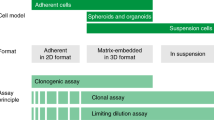Summary
Cell culture systems allow the examination of cell populations in a functional state. To simulate in vivo conditions as closely as possible freshly established cell strains are superior to permanent cell lines. Different aspects for the establishment of primary cell cultures obtained from various tissues are compared: (1) Disintegration, (2) culture media supplemented with basal additions, (3) special supplements (growth factors, hormones), and (4) attachment factors. The proliferation rates of the attained cell strains were evaluated by determination of cell doubling times. Procedures for how to obtain a relatively high plating efficiency (approx. 70% in our series of 219 attempts) of primary growth in vitro are described: (1) Mechanical disintegration is superior to enzymatic digestion. If mechanical treatment alone did not produce a sufficient number of viable cells, additional digestion with collagenase/dispase revealed a higher number of proliferating primary cultures than with trypsin. (2) Proliferation of cell cultures from normal and tumorous tissues of epithelial origin was superior in Leibovitz L 15 medium (58 of 87 (67%) cases). Cultures from mesenchymal tissues and tumors were found to have shortest cell doubling times in MEM and RPMI 1640 (16 of 23 (70%) cases). The media were supplemented with the basal additions indicated. (3) In approx. 30% of the cases special supplements like growth factors or hormones increased cell replication, although they were almost always not essential for cell growth. (4) Attachment factors only rarely contributed to the initiation of primary monolayer cultures. The application of various culture conditions does not lead to a protocol optimal for all tissues, for all probes of the same type of tumor, or for all tumor specimens of unique differentiation.
Similar content being viewed by others
Abbreviations
- EGF:
-
epidermal growth factor
- FGF:
-
fibroblast growth factor
- GHL:
-
glycyl-L-histidyl-L-lysine
- PAN:
-
pancreozymin
- E:
-
estrogen
- PR:
-
progesterone
References
Albrecht M, Simon WE, Hölzel F (1985) Individual chemosensitivity of in vitro proliferating mammary and ovarian carcinoma cells in comparison to clinical results of chemotherapy. J Cancer Res Clin Oncol 109:210–216
Calabresi P, Dexter L, Heppner GH (1979) Clinical and pharmacological implications of cancer cell differentiation and heterogeneity. Biochem Pharmacol 28:1933–1941
Cowell JK (1983) Chromosome changes associated with epithelial cell transformation with special references to in vitro systems. In: Franks LM, Wigley CB (eds) Neoplastic transformation of differentiated epithelial cell systems in vitro. Academic Press, New York, pp 159–286
Dendy PP, Hill BT (1983) Human tumor drug sensitivity testing in vitro. Academic Press, New York
Dietel M, Hölzel F, Arps H, Simon WE, Albrecht M (1985) Mammacarcinome in vitro: Zytoskelett, Tumormarker, Zellkern-DNA und Wachstumsgeschwindigkeit in Abhängigkeit von Hormonen und Zytostatika. Verh Dtsch Ges Pathol 69:212–217
Dietel M, Arps H, Klapdor R, Müller-Hagen S, Hoffmann L (1986) Antigen detection by the monoclonal antibodies CA 19-9 and CA 125 in normal and tumor tissue and patient's sera. J Cancer Res Clin Oncol 111:257–265
Dietel M, Hölzel F, Arps H, Gerding D, Trapp M, Simon WE, Albrecht M (1986) Chemosensitivity testing in proliferating monolayer cell cultures of malignant tumors. J Cancer Res Clin Oncol 111:51
Fogh J (1975) Human tumor cells in vitro. Plenum Press, New York
Franks LM (1983) Morphological criteria for tumor cell differentiation. In: Dendy PP, Hill BT (eds) Human tumor drug sensitivity testing in vitro. Academic Press, New York, pp 7–18
Gibson-D'Ambrosio RE, Samuel M, D'Ambrosio SM (1986) A method for isolating large numbers of viable disaggregated cells from various human tissues for cell culture establishment. In Vitro 22:529–534
Ham RG (1981) Survival and growth requirements of nontransformed cells. In: Tissue culture factors. Springer, New York, pp 13–88
Hamburger A, Salmon SE (1977) Primary bioassay of human tumor stem cells. Science 197:461–463
Hölzel F, Albrecht M, Simon WE, Hänsel M, Metz R, Schweizer J, Dietel M (1985) Effectiveness of antineoplastic drugs on the proliferation of human mammary and ovarian carcinoma cells in monolayer culture. J Cancer Res Clin Oncol 109:217–226
Jolly J (1903) Sur la durée de la vie et de la multiplication des cellules animales en dehors de l'organisme. C R Soc Biol (Paris) 55:1266
Leibovitz A (1986) Development of tumor cell lines. Cancer Genet Cytogenet 19:11–19
McBrain JA, Weese JL, Wolberg WH, Wilson JKV (1984) Establishment and characterization of human colorectal cancer cell lines. Cancer Res 44:55–5821
National Institutes of Health (1985) Catalog of cell lines. NIH Publication no. 85-2011
Owens RB, Smith HS, Nelson-Rees WA, Springer EC (1976) Epithelial cell cultures from normal and cancerous human tissue. JNCI 56:843–849
Parker RC (1960) Methods of tissue culture (3rd edn). Hoeber, New York
Paul J (1975) Cell and tissue culture. Churchill and Livingstone, Edinburgh, London, New York
Sharkey FE, Spicer JH, Fogh J (1985) Changes in histological differentiation of human tumors transplanted to athymic nude mice: a morphometric study. Expl Cell Biol 53:100–106
Simon WE, Albrecht M, Hänsel M, Dietel M, Hölzel F (1983) Cell lines derived from human ovarian carcinomas: growth stimulation by gonadotropic and steroid hormones. JNCI 70:839–845
Simon WE, Albrecht M, Trams G, Dietel M, Hölzel F (1984) In vitro growth promotion of human mammary carcinoma cells by steroid hormones, tamoxifen, and prolactin. JNCI 73:313–321
Soule HD, McGrath CM (1985) A simplified method for passage and long-term growth of human mammary epithelial cells. In Vitro Cell Dev Biol 22:6–12
Author information
Authors and Affiliations
Additional information
Supported by the Deutsche Forschungsgemeinschaft, grant Di 276/1–2, SFB 232, Hamburger Landesverband zur Krebsbekämpfung und Krebsforschung, and Hamburger Stiftung zur Förderung der Krebsbekämpfung
Rights and permissions
About this article
Cite this article
Dietel, M., Arps, H., Gerding, D. et al. Establishment of primary cell cultures: Experiences with 155 cell strains. Klin Wochenschr 65, 507–512 (1987). https://doi.org/10.1007/BF01721036
Received:
Revised:
Accepted:
Issue Date:
DOI: https://doi.org/10.1007/BF01721036




